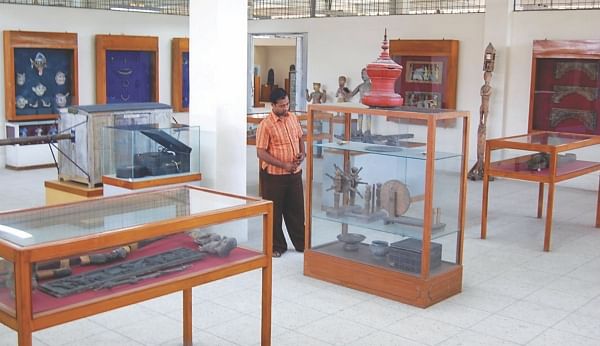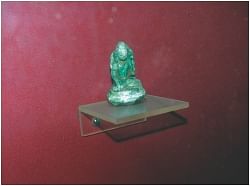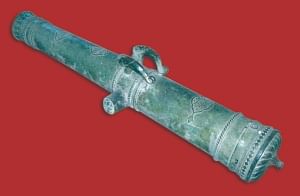| Home - Back Issues - The Team - Contact Us |
 |
| Volume 11 |Issue 40| October 12, 2012 | |
|
|
Chittagong
A Treasure-trove Arun Bikash Dey Chittagong University Museum is a treasure-trove of rich antiquities. As tools of visual education, museums play a vital role in creating an academic atmosphere. It not only works as a storehouse of knowledge and beauty but also occupies the foremost place in organising teaching and research in an educational institution. Unfortunately educational institutions in Bangladesh do not have access to a good number of museums in order to enrich the students with archaeological knowledge. In the absence of a general museum in the eastern region of the country, Chittagong University Museum is serving the interests of the general public as well as that of researchers.
Chittagong University Museum, which is the only university-museum in Bangladesh, started its journey in June 14, 1973 with the initial collection of 30 pieces of art and objects of antiquity that included nine pieces of robes and pillows, 14 pieces of arms and armaments, two stone inscriptions, two sculptures, one architectural member and two offering plates made of brass. These arts and objects collected by the University's Department of History were handed over to the museum at the time of its journey. Ziauddin Chowdhury, display officer of the museum, says that the major portion of this collection came as donation from the then National Bank of Pakistan through the courtesy of its late managing director and a patron of arts and antiquities Mumtaz Hasan. Nurul Quader Khan, ex-additional deputy commissioner of Rajshahi, and Mohiuddin Hossain of Mirsarai, Chittagong donated two sculptures to this department, he says, adding that the other objects were acquired through joint survey work of the teachers and students of the Department. Professor AR Mallick, the first Vice-Chancellor of the University and Professor Abdul Karim, the first head of the Department of History took an active interest in building up the collection of the department. Dr Shamsul Hossain, a former student of the Department of History, was the first academic staff and one of the initiators of the museum. He, later, served as the deputy-curator.
The museum was temporally established on the first floor of the Arts Faculty. A few days later it was shifted to Zila Shilpakala Academy in the port city and again to the third floor of the AR Mallick Bhaban of the University in 1988. It found its own place in the Library and Museum Building on August 10, 1992. “When I was a student of the History Department at CU during 1967-68, I used to go out for field work in different areas of the country with our teacher Professor Dr Abdul Karim, the then chairman of the department,” says Dr Shamsul Hossain,“I found a lot of objects of antiquities at sixes and sevens in different areas. Then I thought to collect these objects and preserve those at one place.” He says that while working as a research fellow of districts record collection, a project of the History Department, he also found that a lot of documents were at sixes and sevens. "So from an intention of gathering all the objects of antiquities and documents we found in different areas at one place I thought of establishing a museum in the CU campus,” he adds. Moksudur Rahman, an assistant of the reference library of the museum, says that about 100 persons visit the museum on average a day but the number increases to about 3000 on special occasions like admission tests. When contacted, Professor Anwarul Azim Arif, vice-chancellor of the university, says that the authority has taken some new initiatives to further enrich the museum. “We have four galleries in which we have decided to put and display the relics that were displayed at 'Chirayato Chattagram Prodarshani,' (Eternal Chittagong Exhibition) organised by The Daily Star as part of its 'Odommo Chattagram' (Indomitable Chittagong) festival in March- April,” he says. The museums remains open to all from 8.00am to 1.30pm. The writer is a Staff Reporter, The Daily Star, Chittagong Bureau. Galleries: In the archeology and pre-historic gallery, there are a huge number of pictures, fossils, clay idols and plaques of burnt clay from the ancient times. In the sculpture gallery, there are touchstone idols, wooden idol, idols related to Hindu religion like Bishnu Murti, Shib Lingo, Suriya Murti and many other idols ranging from 8th to 12th centuries. Cannon of Mughal period, gold and silver coins of Mughal emperors, inscriptions on papyrus paper, hand-written Qurans, arms of medieval age, pictures of ancient mosques and their ruins, Islamic calligraphic pictures, stone inscriptions and decorated stone with Terra Cotta are available in the Islamic art gallery. In the folk art gallery, there is a huge collection of household utensils made of brass, copper and aluminium of 17th to 18th century. Baskets made of cane, lanterns, Hukka (tobacco pipe), clay plaque, tribal ornaments, clay sculpture, clay puppet, pati (mat) and Nakshi Kantha (embroidered quilt) of 17th to 18th centuries are also available in the gallery. Paintings of Shilpacharya Zainul Abedin, Kamrul Hasan, Rashid Chowdhury, Zia Uddin Chowdhury and Nitun Kundu are grace the art gallery, along with Syed Abdullah Khaleed's sculpture. There is a part of mural picture titled 'Abahoman Bangla and Bangalee' in the art gallery. Reference Library: In the archive, the rare documents of Liberation War and other valuable documents are preserved with a collection of manuscripts and printed documents, books, booklets, posters, pamphlets and other objects. Museum Park: There is a mukta mancha (open stage) in the park, where cultural programmes are held. |
||||||||
Copyright
(R) thedailystar.net 2012 |


